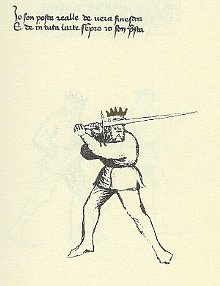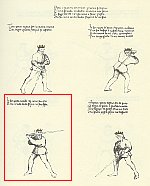| Fiore dei Liberi: Flos Duellatorum, 1410 (Pisani-Dossi, F. Novati, Bergamo, 1902) |
| 4 spada longa - longsword |
4.1.3 posta de finestra  , instabile1 (guard of the window) , instabile1 (guard of the window) |


Io son posta realle de uera finestra
E de tuta l'arte sempre io son presta |
I am the royal guard of the true window
And of all the art I am always the quickest |
Synopsis: The description of "window" or finestra suggests that the wielder is peering through a window under its "sash", represented by the blade of the sword held just above the eyes across the forehead. Given this, it can be deduced that the blade is not actually pointed in the direction of the opponent, but rather somewhat off-line in order to give the appearance of peering through a window. The reference to "true" is not clear within the context of this guard given he uses the same description with a later guard of the window. Other possible translation context could include "real" or "pure" which could possibly be used as the descriptive term as well, however, it doesn't actually clarify the purpose of using such a descriptive term. Another possibility is that it is simply held over the right shoulder, considering the culture that the right was "good" and the left was "bad" in that period. In the second line of the verse, Fiore hints as to the effectiveness of such a guard in terms of both coverage and attacking. Given such a guard, it is implied that its deployment is quick and effective against all of the other guards he described in the treatise.
Application: The posta de finestra or guard of the window has occassionally been referred to as the "holy shit guard". The reason for this less than elegant name for this guard was reasoned that the position of the sword was almost horizontal to the ground, and the tip pointed either to the left or right of the opponent somewhat off-line, and that this guard can be deployed quickly as a result of being surprised and achieving this guard position as a reactionary movement and often was preceded with a verbalized "holy sh..." when deployed. Also, the orientation of the torso with respect to the opponent is such that the chest remains someone perpendicular to the opponent's centre line. Further study indicates that the point is indeed oriented towards the opponent somewhat off-line and that the foot placement is such that the opponent views the "edge" of the body with the left foot forward and oriented towards the zugadore. A far more effective deterent to the opponent when the sword is pointed towards his/her face. Upon further examination of the illustration, realizing that if the body was positioned broadside to the opponent, and the sword when raised was in front of the eyes, the individual would be blinded by the blade. Therefore, the second interpretation is deemed incorrect, and through practical experience in training and combat, the original interpretation is the more viable one.
The orientation of the body and placement of the sword, along with the reference to instabile provides additional clues that confirms the orientation of the body and sword and that in order to deploy either a cut or thrust, a passing step is required for an effective delivery.
Footnotes
- instabile refers to delivering a blow (thrust or cut) while one takes a full step (a passing step) to reach the target. This info was derived from the Getty's version of Liberi's treatise.
 , instabile1 (guard of the window)
, instabile1 (guard of the window) , instabile1 (guard of the window)
, instabile1 (guard of the window)